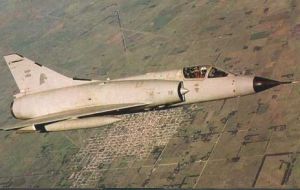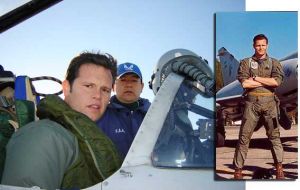MercoPress. South Atlantic News Agency
Malvinas Mirage III crashes during “baptism of fire” celebration
 Interceptor Mirage III
Interceptor Mirage III The Argentine Air Force “baptism of fire” 25th celebration turned into tragedy Tuesday morning when a Mirage III interceptor after two successful low flying demonstrations crashed in a field next to the Tandil VI Air Brigade.
The pilot apparently did not have time to eject because he flew the aircraft away from the populated area. On May first 1982 the Argentine Air Force for the first time engaged in air combat with "enemy forces", British aircrafts from the Task Force sent by the United Kingdom to the South Atlantic to recover the Falkland Islands. Since then May first is remembered as "baptism of fire" day. The accident occurred at 11:10 AM apparently when the pilot run into a fog bank at the end of the air strip following a low flying pass. Defence Minister Nilda Garré who presided over the main celebration in Moron Air Base ordered all Mirage aircrafts grounded until a full investigation into the accident is completed "The causes of the accident are under investigation", said minister Garré adding that "Mirages are grounded until we determine how the accident happened; the pilot was in contact until a minute before the accident". The French built Dassault Mirage III proved to be an outstanding fighter plane during the Falklands conflict. However the Argentine Air Force has suffered a string of accidents in the last 30 months with the loss of several pilots including a Jet Lear in Bolivia that almost cost the life to a cabinet minister. According to official numbers in the last two decades Argentine Air Force aircrafts were involved in 76 accidents which brings again into public debate controls and maintenance of military equipment. This is particularly true since last year following the airing of a film about the lack of air security in Argentine airports produced by civilian pilot Enrique Piñeyro. Mr Piñeyro made an extensive investigation into the shortcomings and mistakes leading to the 1999 tragic accident in Buenos Aires domestic shuttle airport, Aeroparque, when a passenger aircraft run off the landing strip and ended in the River Plate waterfront. The investigation showed that civilian airports, including Ezeiza, lack the minimum radar and air surveillance equipment to ensure air traffic safety. Civilian airports management and air comptrollers have since 2006 ceased to be under Air Force responsibility and now depend from a civil aviation agency.





Top Comments
Disclaimer & comment rulesCommenting for this story is now closed.
If you have a Facebook account, become a fan and comment on our Facebook Page!